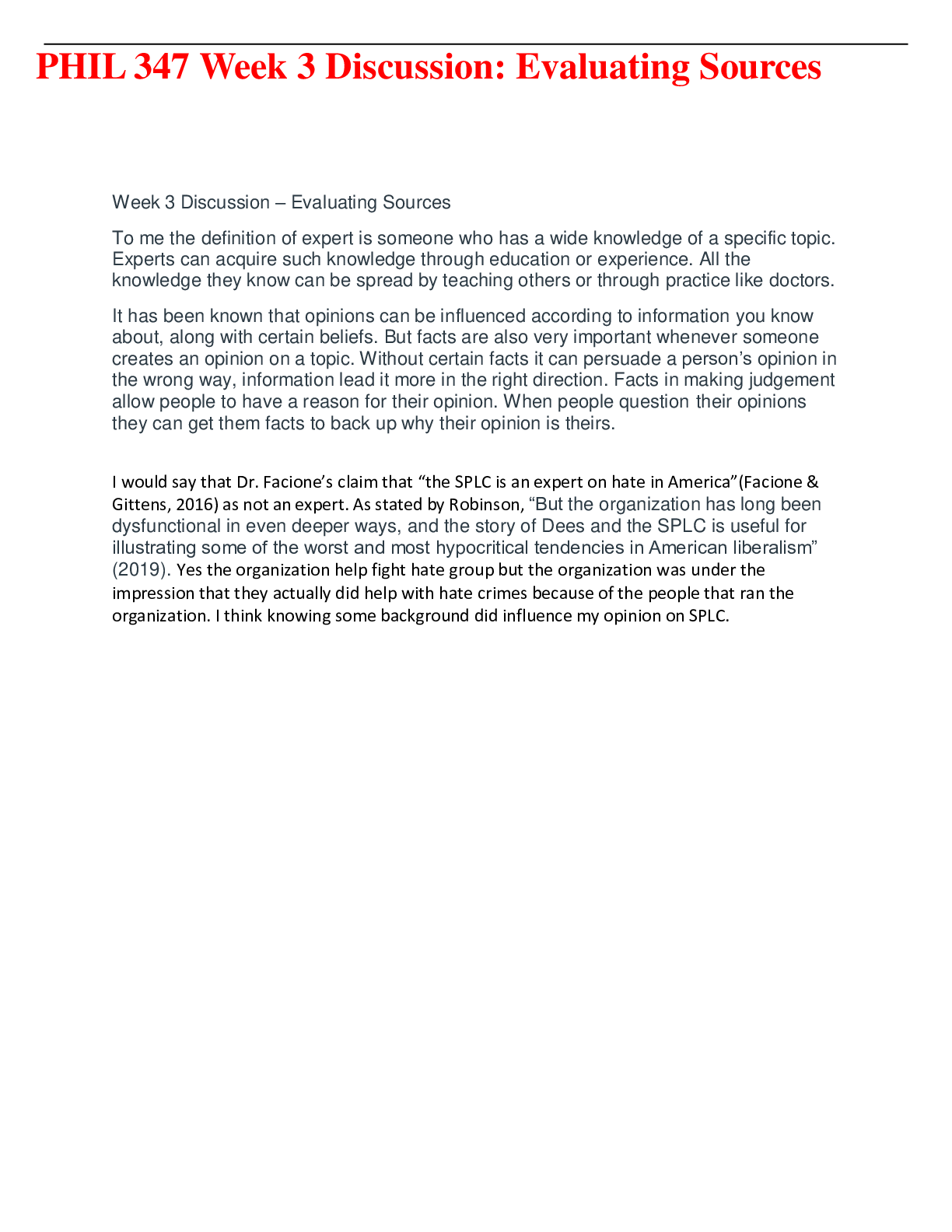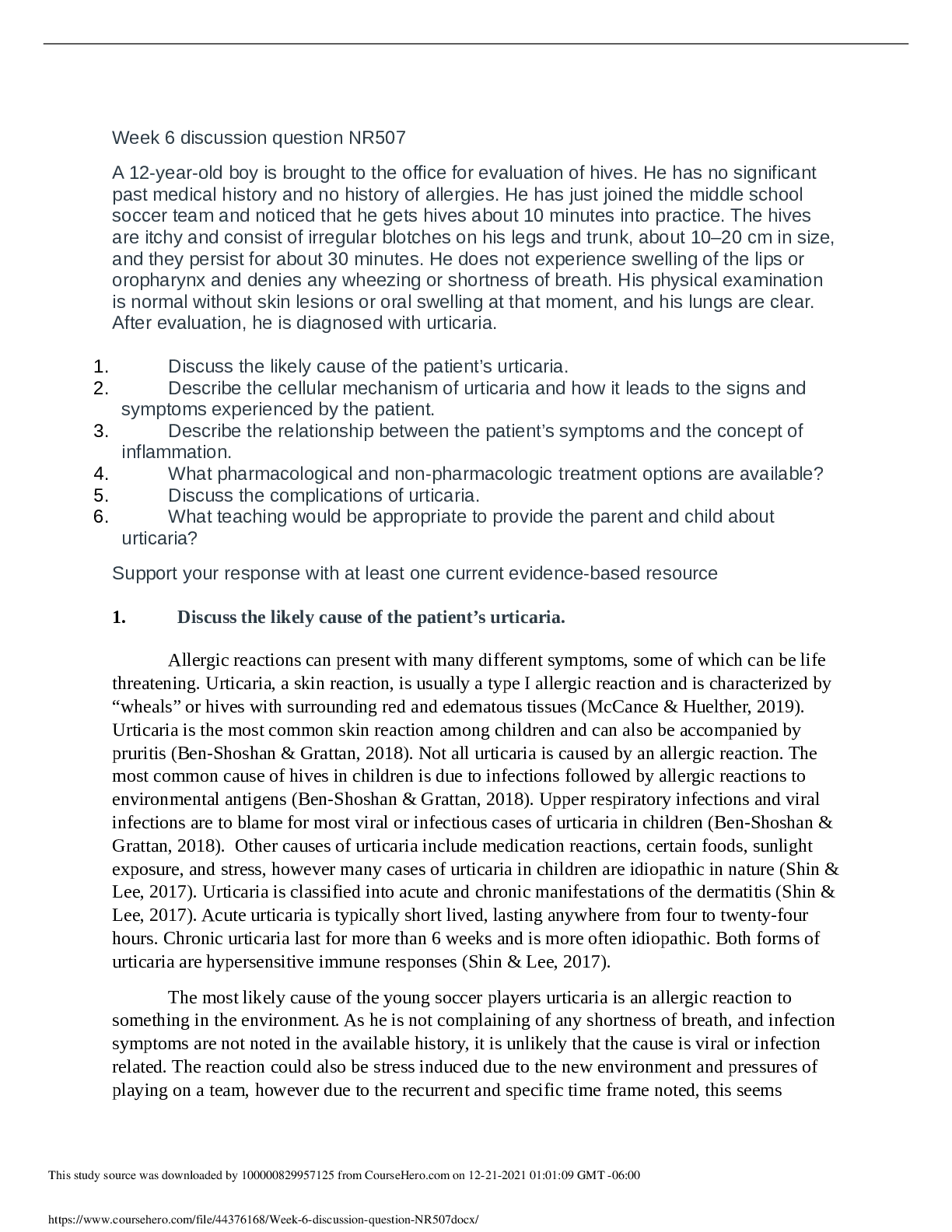*NURSING > DISCUSSION POST > NR 509 Week 5 class discussion – Chamberlain college of Nursing | Women's Health and the Interview (All)
NR 509 Week 5 class discussion – Chamberlain college of Nursing | Women's Health and the Interview
Document Content and Description Below
NR 509 Week 5 class discussion – Chamberlain college of Nursing Week 5: Women's Health and the Interview 44 unread replies.5656 replies. Using a friend, family member, or colleague, perform ... a detailed women’s health history. Document the history and the expected normal physical examination findings in the SOAP note format. Even though your patient may have abnormal findings, you must document the expected normal exam findings for the system. If you would like to include the abnormal findings they should be noted in parenthesis next to the normal expected findings. The complete subjective and objective sections must be included. You may include the assessment and plan portion of the SOAP note, but these sections will not be graded. You should devise a chief complaint so that you may document the OLDCART (HPI) data. You must use the chief complaint of burning while urinating, irregular menstrual cycle, or pelvic pain. You should also focus the ROS based on the patient’s chief complaint and the body systems being examined. Refer to the SOAP Note Format document in Course Resources as necessary. This will be the same format that faculty will follow during the immersion weekend. * There are videos of the exams to be performed at immersion in Modules → Introduction and Resources→ Immersion section. Also the immersion evaluation forms are located in the Course Resources section. They should be reviewed and practiced often. This topic was locked Aug 6 at 11:59pm. Search entries or author Filter replies by unreadUnread Collapse replies Expand replies Subscribed • Tiffany Lunsford Tiffany Lunsford Jul 30, 2017Jul 30 at 6:26pm Manage Discussion Entry Hello Class and welcome to Week Five! This week we will be working on the detailed breast and genitourinary exam in women. This is an area where I urge you to know common health history, preventive education, and preventive screening guidelines. For example, who should get a cervical cancer screening, how often, and why? What women should be screened for STI’s and why? Keep these important preventive health topics in mind. To Do List for Week 5 Readings Jarvis, C. (2016). Physical examination & health assessment (6th ed.). Philadelphia, PA: Saunders. •Chapter 17: Breasts and Regional Lymphatics •Chapter 26: Female Genitourinary System •Chapter 30: The Pregnant Woman Swartz, M. H. (2014). Textbook of physical diagnosis: History and examination (6th ed.). Philadelphia, PA: Saunders. •Chapter 13: The Breast •Chapter 16: Female Genitalia •Chapter 20: The Pregnant Patient Participate in the Discussion Question Practice of all assessment skills this far in the class as this will assist you with return demonstration at Immersion weekend. Complete the QBank practice questions Course Outcomes for Week 5: (CO’s 4, 6, & 8) 4. Complete a comprehensive health history and examination for developmental, gender-related, age-specific, and specific populations (PO 1, 5) 6: Differentiate normal from abnormal findings. (PO 1, 4) 8: Adapt history and physical examination to the needs of the patient, i.e., pediatric versus geriatric patient. (PO 1, 4, 7). Remember that your main post is due by Tuesday at 11:59pm (MT). Please let me know if you have any questions! Dr. Lunsford • Collapse SubdiscussionJessica Hopkins Jessica Hopkins Jul 31, 2017Jul 31 at 6:13pm Manage Discussion Entry Dear Class and Dr. Lunsford; Patient Information: KH, 20, Female, Caucasian, BCBS S. CC burning with urination HPI: Onset: 3 days ago Location: vaginal area, urethra Duration: three days Characteristics: discomfort with urination, vaginal irritation Aggravating Factors: urinating Relieving Factors: drinking a lot of water, AZO OTC medication for urinary tract discomfort Treatment: AZO OTC medication Current Medications: AZO OTC urinary tract relief, occasional Motrin 200mg for pain or headache, Ventolin albuterol inhaler 1-2 puffs as needed Allergies: no known drug allergies, allergies to pollen, dust mites, mold, corn husks PMHx: history of sports-induced asthma, up-to-date on all immunizations, received all three of the HPV vaccines at age 12, has had the meningitis vaccines, last tetanus 05/2016, receives a yearly influenza vaccine Soc Hx: patient sitter at a local hospital, enjoys spending time with her boyfriend of one year, watching movies, and painting, is a full-time student at Michigan State University in her third year studying neurology with a double major in psychology, denies any tobacco or alcohol use. Wears her seatbelt always, uses condoms always and is in a monogamous relationship. Fam Hx: father has seasonal allergies, denies any history of mother, father’s side grandmother with hypothyroid, vitiligo, grandfather had a massive heart attack underwent triple bypass still living, no history of medical illnesses with siblings (brother and sister), mothers side grandmother left hip replacement, grandfather alcoholic and high cholesterol ROS: CONSTITUTIONAL: No weight loss, fever, chills, weakness or fatigue. HEENT: Eyes: No visual loss, blurred vision, double vision or yellow sclerae. Ears, Nose, Throat: No hearing loss, sneezing, congestion, runny nose or sore throat. SKIN: No rash or itching. CARDIOVASCULAR: No chest pain, chest pressure or chest discomfort. No palpitations or edema. RESPIRATORY: No shortness of breath, cough or sputum. GASTROINTESTINAL: No anorexia, nausea, vomiting or diarrhea. No abdominal pain or blood. GENITOURINARY: Positive for burning on urination. Positive for urgency of urination. Denies pregnancy. Last menstrual period, 07/11/2017. NEUROLOGICAL: No headache, dizziness, syncope, paralysis, ataxia, numbness or tingling in the extremities. No change in bowel or bladder control. MUSCULOSKELETAL: No muscle, back pain, joint pain or stiffness. HEMATOLOGIC: No anemia, bleeding or bruising. LYMPHATICS: No enlarged nodes. No history of splenectomy. PSYCHIATRIC: No history of depression or anxiety. ENDOCRINOLOGIC: No reports of sweating, cold or heat intolerance. No polyuria or polydipsia. ALLERGIES: History of asthma, hives, eczema or rhinitis. O. Physical exam: for the purpose of this week’s discussion and case, a female genitourinary, breast, and rectal exam shall be performed. Constitutional: Vitals: BP 100/62, HR 71, R 14, T 97.1, pain 3/10, HT 5’2”, 135 pounds, BMI 24.7 KH is a&0x3, well kempt, healthy, and appropriate in size and shape for height Breasts: Moderate in size, pendulant, symmetric, skin pink and pale with freckles noted, light brown areola bilateral with piercings noted, freely moving with positional changes of arms and hands, nipples everted bilaterally, no dimpling, retractions, lesions, or inflammation noted, axillae shaved and free from hair, rashes, or inflammation, no masses or tenderness noted on palpation, bilateral mammary ridge present, no discharge noted from nipples, piercings healed and show no signs of infection bilaterally, no inflamed lymph nodes present in axillae, demonstrates proper self-breast exams, lying down the concentric circle pattern method was used to perform the palpation of the breasts and no masses or lumps felt bilaterally Genitalia: No hair to examine distribution, but hair follicles present and admits to shaving her pubic hair, no lesions, masses or swelling noted, labia majora pink and smooth, free of lesions, excoriation, and swelling, labia minora dark pink, moist, and free of lesions, excoriation, swelling, or discharge, no discharge noted in the vaginal opening or urethral opening (some redness noted at the urethral opening), no odor noted on exam, on speculum exam no discomfort noted with insertion, no bulges noted with bearing down, vaginal mucosa pink, no lesions or redness noted, cervical os is midline with no discharge or lesions noted, denies any tenderness on palpation, bimanual exam displays no tenderness on palpation of the right and left ovary, adnexa not palpated, uterus is midline, smooth, normal in size Rectum and anus: Anal opening is hairless, moist, and closed with no masses, lesions, or tearing noted, perineum smooth and free of lesions, rashes or swelling, when asking to bear down no lumps or protrusions of the rectum noted, anus is smooth, non-tender, and free of nodules or hardness, digital exam demonstrates no lumps or lesions, no blood detected on the occult card, normal sphincter tone After examining KH we discussed further the symptoms she had been experiencing over the last three days and she stated that she started having minimal discomfort with urinating after having intercourse with her boyfriend. They hadn’t had intercourse in three weeks. She denied any discomfort during intercourse and used the same latex condom they have been using previously. She also stated that she didn’t urinate after coitus and fell asleep. Normally she urinates and washes up after. The discomfort increased over the course of two days and is now experiencing urgency and pain on urination. She reported her pain to be a 3/10 on the numeric pain scale. She has been trying to increase her daily intake of water and has been using AZO urinary tract health pills OTC for the last two days with no relief. KH is presenting with the classical signs of a non-complicated urinary tract infection (UTI) and is very common in women. According to Butler et al. (2015) UTI’s are one of the most common reasons why females seek primary care and these account for approximately $2 billion per year in healthcare costs. It has been reported that approximately one-third of the women that are treated with antibiotics do not take the medication as prescribed once they feel better, but this poses a great risk for our ever-concerning problem these days of antibiotic resistance (Butler et al., 2015). According to Stiller, Hicks, and Saul (2017) antibiotic resistance is becoming more widespread and so as advanced practitioners, it would be more beneficial for the patient and for our treatment plan’s efficacy if we were to obtain a urine culture sensitivity along with the urinalysis especially in those that present with reinfections often. According to Davis and Rantell (2017) UTI’s can be classified in two categories either uncomplicated or complicated and the detection of infection at an early stage and prompt treatment is key. Of the uncomplicated category it usually appears in women over the age of 14, not pregnant, have no renal impairments, or abnormalities of the urinary tract while the complicated category involves women that may have underlying issues causing the infection, poor hygiene, frequent recurring UTI’s (Davis & Rantell, 2017). When discussing treatment options with KH, I made her aware of evidence-based studies that have proven the use of cranberry juice or treatments OTC, such as AZO to be ineffective and would serve as an injustice to her if she were to continue this regimen (Nicolle, 2016). It was proven that the use of cranberry methods was an insufficient means of antimicrobial treatment and that with the symptoms she is experiencing another treatment regimen is recommended in my professional opinion (Nicolle, 2016). According to Stiller, Hicks, and Saul (2017) an antibiotic regimen for an uncomplicated UTI would start out with the use of Nitrofurantoin (Macrobid), oral 2nd and 3rd generation cephalosporins such as cefaclor, and or the use of trimethoprim-sulfamethoxasole such as Bactrim for 4 to 7 days. My choice was Macrobid 100mg four times daily for 7 days and also Pyridium 100mg three times daily for three days for relief of the pain with urination. In summary, I discussed with KH the importance of taking the medications as prescribed for the full course of the 7 days even if she were to feel better after a few days to prevent the risk of developing a resistance to the antibiotic and also that these medications would discolor her urine to an orangey-reddish color in nature and that is a normal finding. I would also instruct her to immediately report any adverse side effects to the medications and contact me if symptoms are worsening as uncomplicated UTI’s can quickly lead to more severe complicated forms such as pyelonephritis and potentially require hospitalization. I instructed her to discontinue the use of the AZO at this time. We discussed in detail the importance of proper hand hygiene and after intercourse genitalia hygiene as well to prevent recurrent infections. A follow-up visit was made to recheck the urine to determine if the infection is in fact gone or if other measures need to be pursued. KH was very open and honest in our interview and more than willing to be an active member of her treatment team. Education and honest, open communication is key for an advanced practice nurse to be an effective practitioner! References: Butler, C. C., Hawking, M. D., Quigley, A., & McNulty, C. M. (2015). Incidence, severity, help seeking, and management of uncomplicated urinary tract infection: a population-based survey. The British Journal of General Practice: The Journal Of The Royal College Of General Practitioners, 65(639), e702-e707. doi:10.3399/bjgp15X686965 Davis, C., & Rantell, A. (2017). Lower urinary tract infections in women. British Journal of Nursing, 26(9), S12-S19. Nicolle, L. E. (2016). Cranberry for prevention of urinary tract infection?: Time to move on. Jama, 316(18), 1873-1874. doi:10.1001/jama.2016.16140 Stiller, R., Hicks, C., & Saul, Z. (2017). Treating UTIs in the age of antibiotic resistance. Contemporary OB/GYN, 62(2), 30-36. o Amanda Russo Amanda Russo TuesdayAug 1 at 10:15am Manage Discussion Entry Hello Jessica, I enjoyed reading your post. I too chose the complaint of burning with urination, and diagnosed my patient with a urinary tract infection (UTI). UTIs are the most common bacterial infection in women of all ages (Arnold, Hehn, & Klein, 2016). Risk factors for UTIs include sexual intercourse three or more times a week, spermicide use, and new or multiple sex partners (Arnold, Hehn, & Klein, 2016). Patients need to be educated on the risk factors which contribute to UTIs, especially those women who suffer from recurrent UTIs. Patients who have fever, nausea, vomiting, acute back pain, and vaginal discharge are in need of further work up because these could all be signs of a complicated infection (Arnold, Hehn, & Klein, 2016). I informed my patient to drink plenty of fluids. I also informed her that she could take Motrin 1-2 tablets every 4-6 hours PRN or Azo 2 tablets three times a day PRN for the pain if she would prefer. I also started her on Trimethoprim/Sulfamethoxazole 160/800 mg BID for three days. I chose this medication because it is one of the first-line treatment medications, and it is only required to be taken for three days. “Compared with longer treatment durations, three-day courses of bactericidal antimicrobials are associated with fewer adverse effects, improved treatment adherence, and similarly low risk of progression to pyelonephritis (less than 1%)” (Arnold, Hehn, & Klein, 2016, p. 563). Reference Arnold, J., Hehn, L., Klein, D. (2016). Common questions about recurrent urinary tract infections in women. American Family Physician, 93(7), 560-569. o Collapse SubdiscussionTiffany Lunsford Tiffany Lunsford TuesdayAug 1 at 4:44pm Manage Discussion Entry Hi Jessica. Great job this week! You completed a very thorough note. Two questions. 1. Would you prescribe the Macrobid QID or BID? 2. What are the current guidelines for this age group in terms of pap smears? Dr. L ♣ Collapse SubdiscussionJessica Hopkins Jessica Hopkins WednesdayAug 2 at 7:48pm Manage Discussion Entry Dr Lunsford and Class; Thank you for the response! To answer your questions, I was basing the Macrobid QID off of the article I read from Stiller, Hicks, and Saul (2017) as a first line of defense against bacteria within the lower urinary tract, but I would have to say that I've seen it in practice as BID x 7 days. This method would promote better compliance of the patient as it is taken only twice a day for one short week. I would also definitely resort to what the culture and sensitivity of the urine displayed to ensure that I was using the correct antibiotic that would be best for the patient. According to the Centers for Disease Control and Prevention (CDC) (2017) and the United States Preventive Services Task Force (2012) pap smears are not recommended for this age group, but rather to start the screening for cervical cancer with a pap smear in the age group of 21-65. It is an unnecessary use of resources and money for those under 21. In my personal opinion, each case is individualized as you may have a 19 or 20 year old that has had multiple STI's, multiple partners with unprotected sex, and or pregnancies and to me, that poses a great risk for the possibility of cervical cancer or other serious complications. These guidelines are based off of current evidence-based practice and research that has been done proving that pap smears should not begin until the age of 65 regardless of number of sexual partners, age of sexual initiation, or other risk factors (CDC, 2017). I can tell you from personal experience, I started having children at the young age of 19 with my second child at 21 and I had yearly pap smears when I started my menses at the age of 16. Not sure why, but back then it was the recommended thing in practice and I was compliant. Things have really changed over the years and it's amazing to me to see how research and evidence-based practice really does play a pivotal role in the way we treat and care for those in need and in the goal of health promotion and disease prevention. Jessica References: Centers for Disease Control and Prevention (CDC) (2017). Cervical cancer screening guidelines. Retrieved from https://www.cdc.gov/cancer/cervical/basic_info/screening.html Stiller, R., Hicks, C., & Saul, Z. (2017). Treating UTIs in the age of antibiotic resistance. Contemporary OB/GYN, 62(2), 30-36. US Preventive Services Task Force (2012). Cervical cancer screening. Retrieved from https://www.uspreventiveservicestaskforce.org/Page/Document/UpdateSummaryFinal/cervical-cancer-screening ♣ Tiffany Lunsford Tiffany Lunsford YesterdayAug 6 at 7:27pm Manage Discussion Entry Great rationales, Jessica. I agree that I would prescribe the BID dosing. Thank you for the thorough discussion this week! Dr. L • Collapse SubdiscussionAmanda Russo Amanda Russo TuesdayAug 1 at 9:54am Manage Discussion Entry L.M., 31, F, Caucasian, Medical Mutual S. CC: Burning while urinating HPI: Onset: 3 days ago Location: Groin and pelvis Duration: Throughout urination Characteristics: Burning feeling while urinating, pain in groin and pelvic region as well Aggravating Factors: Walking, not drinking enough fluids throughout the day Relieving Factors: Drinking more fluids, cranberry juice, and rest Treatment: Rest and increase in fluid intake, including cranberry juice Current Medications: Junel 21 1/20 PO daily Allergies: NKA PMHx: UTI No hospitalizations or surgeries Seasonal flu vaccine 9-12-2016 Last tetanus vaccine 8-11-2013 Soc Hx: Registered Nurse for the Cleveland Clinic Enjoys reading, going to the movie theatre, and going out to eat Married with two children Denies the use of tobacco and drugs, and socially uses alcohol once to twice a week consuming 2-6 beers total College education-BSN Heterosexual - - - - - - - - - - - - - - - - - - - - - - SUMMARY: According to Palm-Fischbacher and Ehlert (2012), anxiety and depression are directly related to irregular menstrual cycle. It is expected that an adolescent’s menstrual cycle will be irregular for the first two years after having her first period. However, after the second year, it may be time to investigate into why the periods are irregular. I would consult an obstetrician, order labs to check the hormone levels. A transvaginal ultrasound may be necessary to rule out polycystic ovaries. Birth control in the most commonly prescribed medication to help regulate menstrual cycles (Witchel, et al., 2015). It might be a good idea to have her she assessed by a professional councilor in order to assess anxiety and depression. References Palm-Fischbacher, S., & Ehlert, U. (2014). Dispositional resilience as a moderator of the relationship between chronic stress and irregular menstrual cycle. Journal of Psychosomatic Obstetrics and Gynecology, 35(2), 42-50. Witchel, S. F., Oberfield, S., Rosenfield, R. L., Codner, E., Bonny, A., Ibáñez, L., . . . Lee, P. A. (2015). The diagnosis of polycystic ovary syndrome during adolescence. Hormone Research in Paediatrics, 83(6), 376-389. doi:http://dx.doi.org.proxy.chamberlain.edu:8080/10.1159/000375530 o Collapse SubdiscussionJessica Hopkins Jessica Hopkins WednesdayAug 2 at 8:16pm Manage Discussion Entry Sherry, Nice post! I agree with your opinion to have her see a counselor to dive further into the anxiety and depression. I was reading an article about how stress and anxiety can affect the menstrual cycles. According to Bargar (2017) complex hormones regulate and control our menstrual cycles and our body's reaction to stress and anxiety changes the levels of these hormones causing a potential disruption in our normal cycle pattern. Stress is considered one of the most common causes of late and missed periods (Bargar, 2017). I used to experience high levels of stress in my life and would go months without a period. I can only imagine what others must go through. Jessica Reference: Bargar, R. (2017). Does stress affect your period? Retrieved from http://www.medicinenet.com/ask_does_stress_affect_your_period/views.htm ♣ Sherry Boyd Sherry Boyd YesterdayAug 6 at 10:30pm Manage Discussion Entry Jessica, Thank you for the response. Sherry o Collapse SubdiscussionCatherine Orakpo Catherine Orakpo FridayAug 4 at 9:26pm Manage Discussion Entry Hello Sherry, I couldn’t agree more that different things could cause menstrual irregularities including disease process like ovarian cyst, polycystic ovary syndrome (PCOS), prolactinomas, Asherman’s syndrome, uterine cancer and infertility due to STD’s. Amenorrhea even though it is defined as the absence of menstruation in females due to developmental or functional failure of the endocrine system, reproductive systems with relationship to ovaries, pituitary gland, hypothalamus, genetics, uterus and other numerous factors.. Amenorrhea is presumed to be normal in prepubescent girls and in women who are pregnant, breastfeeding, or postmenopausal however it can also result from a variety of dysfunctions and disorders of which I totally agree that proper assessment will be required by a healthcare provider in other to identify the problem and treat where a better outcome will be achieved. Secondary amenorrhea can be likened to cessation of menses for 6 months in females with previously normal, regular cycles, or cessation of menses for 12 months in females with a history of irregular cycles in any case cessation of this sort can be poblematic as cited by (Satpathy, 2017). Numerous studies have identified health-related factors associated with irregular menstrual cycles, such as age at menarche, body mass index (BMI), physical activity, smoking and restrained eating as cited by (Rowland, et al., 2002). Thanks for sharing. Good job! References Satpathy, H. K. (2017). Amenorrhea. In F. F. Ferri (Ed.), Ferri's clinical advisor 2017: 5 books in 1 (pp. 63-66). Philadelphia, PA: Elsevier. Rowland AS, Baird DD, Long S, et al. Influence of medical conditions and lifestyle factors on the menstrual cycle. Epidemiology 2002;13:668–74. ♣ Sherry Boyd Sherry Boyd YesterdayAug 6 at 10:28pm Manage Discussion Entry Catherine, Thank you for your response to my post. There are indeed several possible causes of amenorrhea. I feel that the best way to discover the cause is to perform a thorough health history and physical exam. Sherry (1 like) o Kara Flatt Kara Flatt YesterdayAug 6 at 5:39pm Manage Discussion Entry Sherry- Thank you so much for your post! It was well written and very informative. I agree that depression and anxiety can be directly related to your patient's menstrual period issues, but something jumped out at me. Your patient is 16 and on Prozac and clonazepam? My concern is not the medication and her age necessarily, but the possible complications that can occur after being on a benzodiazepine for so long. If you patient started clonazepam at the age of 16 and takes it as often as she can, this sets her up for potential dependency which can follow her throughout her life. When used chronically, benzodiazepines can be addicting (Logo & Johnson, 2000). Instead of using a benzo, maybe we could taper it off and teach our patient to use other non-pharmacologic methods to deal with her anxiety. Benzos slow the body down, which can directly affect her menstrual cycle, so I believe looking at the possibility of getting rid of this medication could be beneficial in many areas. Just some thoughts. -Kara References Logo, L., & Johnson, B. (2000). Addiction part 1: benzodiazepines-side effects, abuse risks, and alternatives. American Family Physician, 2121-2128. o Tiffany Lunsford Tiffany Lunsford YesterdayAug 6 at 7:24pm Manage Discussion Entry Hi Sherry. Thanks for your post. When you are examining pediatrics, it is important to note if he parent or POA is present etc (especially with this type of exam). Thanks! Dr. L • Collapse SubdiscussionJessica Allen Jessica Allen TuesdayAug 1 at 11:26pm Manage Discussion Entry Patient Information: T.C. 18 Female Caucasian S. CC (Chief Complaint): Patient presents with complaints of “irregular periods”. HPI: Patient states periods became irregular about 9 months ago. States some months she bleeds for over 2 weeks and other months she doesn’t bleed at all. She feels stress could be an aggravating factor, but she isn’t sure. She feels stressed most months. Patient does not know of any relieving factors. No treatment has been tried to date. Current Medications: Tylenol 325mg- 2 tablets PRN for pain or fever Allergies: NKA PMHx: Patient is up to date on scheduled immunizations. Last tetanus vaccine was 3 years ago when starting high school. She has never had a TB test. Tonsils and adenoids removed when patient was 6. Patient had chicken pox when she was 4. Patient had last pelvic exam approximately one year ago. Everything was normal and healthy at that time. Last dental exam was 6 months ago. She has had a few cavities filled but no major dental issues. Last vision exam was 6 months ago as well. She is nearsighted and wears glasses or contacts to see. No other major illness’, surgeries, or hospitalizations. Soc Hx: Patient is a senior in high school. She has a summer job at the local ice cream shop. During the school year she participates in cheer and tumble. She is in good physical health and stays very active. Patient denies use of alcohol, drugs, or cigarettes. She does have her driver’s license and drives. She states she wears her seatbelt in all vehicles. Home has working smoke and carbon monoxide detectors. Patient denies sexual activity or behaviors. Fam Hx: Patient’s parents are both living. Patient is an only child. Father is diagnosed with angioedema of the GI tract. Mother has acid reflux, depression, and anxiety. Maternal grandmother is living and has acid reflux, bladder prolapse, and uterine prolapse. Maternal grandfather is living and has chronic stomach undiagnosed stomach conditions and anxiety. Paternal grandmother is living and has barrett’s esophagus and kidney disease. Paternal grandfather is not known. ROS: Constitutional- General health ok. No recent weight changes, fatigue, fever, sweats, or weakness. HEENT- Head- No severe or frequent headaches. No dizziness, vertigo, or syncope. Eyes- No problems with vision or double vision. No eye pain, swelling, discharge, or lesions. Sclerae are white. No history of glaucoma or cataracts. Patients wears contacts and glasses. Ears- No hearing loss or difficulty hearing. No earaches or ear infections now. No discharge or tinnitus. No vertigo. No exposure to environmental noises. Ears cleaned with washcloth and occasionally q-tips. Nose- No discharge, sneezing, congestion, runny nose, or congestion. She has the occasional cold. No sinus pain, nose bleeds, or allergies. Mouth/Throat- No mouth pain, bleeding gums, toothaches, sores, or lesions in the mouth. No dysphagia, hoarseness, or sore throat. Tonsils and adenoids removed. Teeth brushed twice daily and flosses most days of the week. Skin- No change in skin color. Color appropriate for race. No pruritus, rash, or lesions. No bruises noted. No history of skin disease. No hair loss or changes in hair texture. No changes in nails. Cardiovascular- No chest pain, palpations, cyanosis, fatigue, dyspnea, orthopnea, or edema. No history of heart murmur, hypertension, heart disease, coronary artery disease, or anemia. Respiratory- No history of lung disease. No chest pain, wheezing, or shortness of breath. No cough or sputum. Gastrointestinal- Good appetite with no recent changes. No food intolerance. No heartburn, indigestion, abdominal pain, nausea, or vomiting. No history of ulcers. No liver or gallbladder disease. No jaundice, appendicitis, or colitis. Normal bowel movements. No rectal bleeding or pain. Genitourinary- Menarche at age 15. Lest menstrual period 7/16/17. Cycle is usual and is every 28 days. Duration is 3-5 days. Flow is normal. No vaginal discharge, itching, sores, or lesions. Not in a relationship that involves sexual intercourse. No STI contact. Never been tested for HIV/AIDS. No history of sexual abuse. (Cycle is irregular. Periods are sporadic and duration varies. Flow seems to be normal.) Neurological- No history of seizures, stroke, or fainting. No weakness, tremors, paralysis, coordination problems, or problems speaking or swallowing. No numbness or tingling. No memory problems. Musculoskeletal- No history of arthritis, gout, joint pain, stiffness, swelling, deformities, or limited range of motion. No muscle pain or weakness. No bone trauma. No skeletal diseases. Hematologic- No history of coagulation problems. No bleeding problems. No excessive bruising. Never had a blood transfusion and never used needles to use drugs. Lymphatics- No enlarged nodes. No history of splenectomy. Psychiatric- No nervousness or mood changes. No depression or anxiety. No suicidal thoughts. Endocrinologic- No blood relative with diabetes. No history of hypoglycemia or hyperglycemia. No increase in hunger, thirst, or urination. No heat or cold intolerance. No sweating or changes in skin. Allergies- No history of asthma, hives, eczema, or rhinitis. O. Physical Exam: Height- 5’3” Weight- 97 lbs Temp- 98.7 F BP- 112/72 Pulse- 82 Resp- 18 HEENT- Normocephalic, no lesions, lumps, scaling, parasites, or tenderness. Face is symmetric. No weakness or involuntary movements. EOMs intact. No nystagmus, ptosis, lid lag, discharge, or crusting. Reflexes equal and reactive to light. Conjunctivae clear. Sclerae white with no lesions or redness. Ear canals clear. Tympanic membrane is pearly grey, landmarks intact, and no perforation. No mass, lesions, tenderness, or discharge. No deformities to nose. Nares patent. Septum is midline. No sinus tenderness. Mouth mucosa is pink and moist. No lesions, sores, or bleeding. Tongue is symmetric. Uvula rises midline on phonation. No tonsils. Gag reflex is present. Skin- Uniform and appropriate for race. Warm and dry. No lesions, birthmarks, bruising, rash, or edema. Mucous membranes pink and moist. Brisk capillary refill. No clubbing, discoloration, or biting of nails. Hair is evenly distributed. Neck is supple with full ROM. Symmetric, no masses, tenderness, or swollen lymph nodes. Trachea is midline. Thyroid nonpalpable and not tender. Cardiovascular- No murmurs heard. Normal heart sounds. No heaves. Apical pulse at 5th ICS in left MCI. No thrills or bruits. S1 and S2 are not diminished or accentuated. No extra heart sounds. Pulse is present and regular at all locations. Respiratory- Chest is symmetric upon inspection. Expansion is symmetric also. Tactile fremitus equal bilaterally. Lung fields resonant. Diaphragmatic excursion 4cm and equal bilaterally. Breath sounds auscultated. No wheezing, rales, or rhonchi. Gastrointestinal- Bowel sounds auscultated in all four quadrants. Stomach is symmetric, soft, and flat. No bruits heard. No masses or tenderness. Umbilicus is midline. No striae, scars, or lesions. (Some nausea and constipation noted. Abdominal fullness and cramping.) Genitourinary- No lesions or discharge noted on external genitalia. Vaginal walls are pink with no lesions. Cervix is pink. No lesions noted. Small amounts of nonodorous, clear discharge. Pap smear, chlamydia, trichomoniasis swabs obtained. No acetowhitening shown when swabbing mucosa with acetic acid. No pain on moving cervix. Uterus is midline. No masses or tenderness. Ovaries not enlarged. No hemorrhoids, fissures, or lesions. Rectal wall intact. No masses or tenderness. No blood in stools. (Pain in lower abdomen, pelvis, and vagina upon palpation of cervix and uterus.) Neurological- Alert and oriented x 4. Appearance, behavior, and speech are appropriate. Memories are intact. Gait is normal. No limp noted. DTRs noted. Musculoskeletal- Full ROM of joints. No pain, deformities, or curvatures of the spine. Full extension, bending, and rotation. Arms and legs symmetric and have full ROM. No pain. No decrease in muscle strength. Diagnostics: Refer to OBGYN for ultrasound or laparoscopy. Diagnosis: Endometriosis, unspecified (N80.9) Endometriosis is a chronic inflammatory condition. Endometrial type tissue is deposited on other pelvic organs. This tissue causes bleeding and scarring. Symptoms of endometriosis are dysmenorrhea, pelvic pain, constipation, nausea, vomiting, back pain, fatigue, abnormal bleeding, and spotting. This patient is currently suffering from several of these symptoms, such as the abnormal bleeding, constipation, and pelvic pain. Conditions that are often associated with endometriosis are autoimmune disorders, IBD, and interstitial cystitis. Endometriosis also causes an increased risk of ovarian cancer. Once diagnosed, treatment usually consists of hormone medications. This can be achieved with birth control pills, implants, or injections (Johnston, Reid, & Hunter, 2015). This patient should ultimately be referred to her OBGYN for further testing and follow up. References Johnston, J. L., Reid, H., & Hunter, D. (2015, February 1). Diagnosing endometriosis in primary care: clinical update. The British Journal Of General Practice: The Journal Of The Royal College Of General Practitioners, 65, 101-102. https://doi.org/:10.3399/bjgp15X683665Links to an external site. Jessica Allen o Jade Balow Jade Balow WednesdayAug 2 at 11:21pm Manage Discussion Entry Dear Jessica, You did a great job on your subjective and objective data assessment! Very thorough! I have several friends that have experienced irregular menstrual cycles in their teen years, and several others that started their cycles very early with excessive bleeding. Several of them were placed on birth control medication to help control cycles at a young age. Regarding your initial differential diagnosis, endometriosis is the most common cause of secondary dysmenorrhea in adolescents and presents a diagnostic challenge, and seems like a great choice for diagnosis for this patient. According to Aggarwal (2017), endometriosis presents with a triad of symptoms including chronic pain, dysmenorrhea and dyspareunia. Incidence of endometriosis has been shown to be as high as 50 to 70 percent in adolescents. Many times presenting symptoms that are Gastrointestinal related or pelvic pain related are misdiagnosed such as IBD or PID (Aggarwal, 2017). The article recommends that a thorough physical exam is key to determining the etiology of the pain in order to accurately exclude other causes. Positive clinical finding will include tenderness on palpation of the vaginal fornices and recto-vaginal septum as well as cervical motion tenderness, palpable nodules in the vaginal fornices, a deviated cervix or blue lesions on the surface of the cervix. Lab testing includes a pregnancy test as well as erythrocyte sedimentation rate and a complete blood count. STI and urine cultures can also be obtained to rule out urinary tract infections and sexually transmitted diseases (Aggarwal, 2017). References: Aggarwal, R. (2017). Endometriosis in adolescents. AOGD Bulletin, 17. PreviousNext [Show More]
Last updated: 2 years ago
Preview 1 out of 128 pages

Buy this document to get the full access instantly
Instant Download Access after purchase
Buy NowInstant download
We Accept:

Reviews( 0 )
$14.50
Can't find what you want? Try our AI powered Search
Document information
Connected school, study & course
About the document
Uploaded On
Aug 15, 2020
Number of pages
128
Written in
Additional information
This document has been written for:
Uploaded
Aug 15, 2020
Downloads
0
Views
88



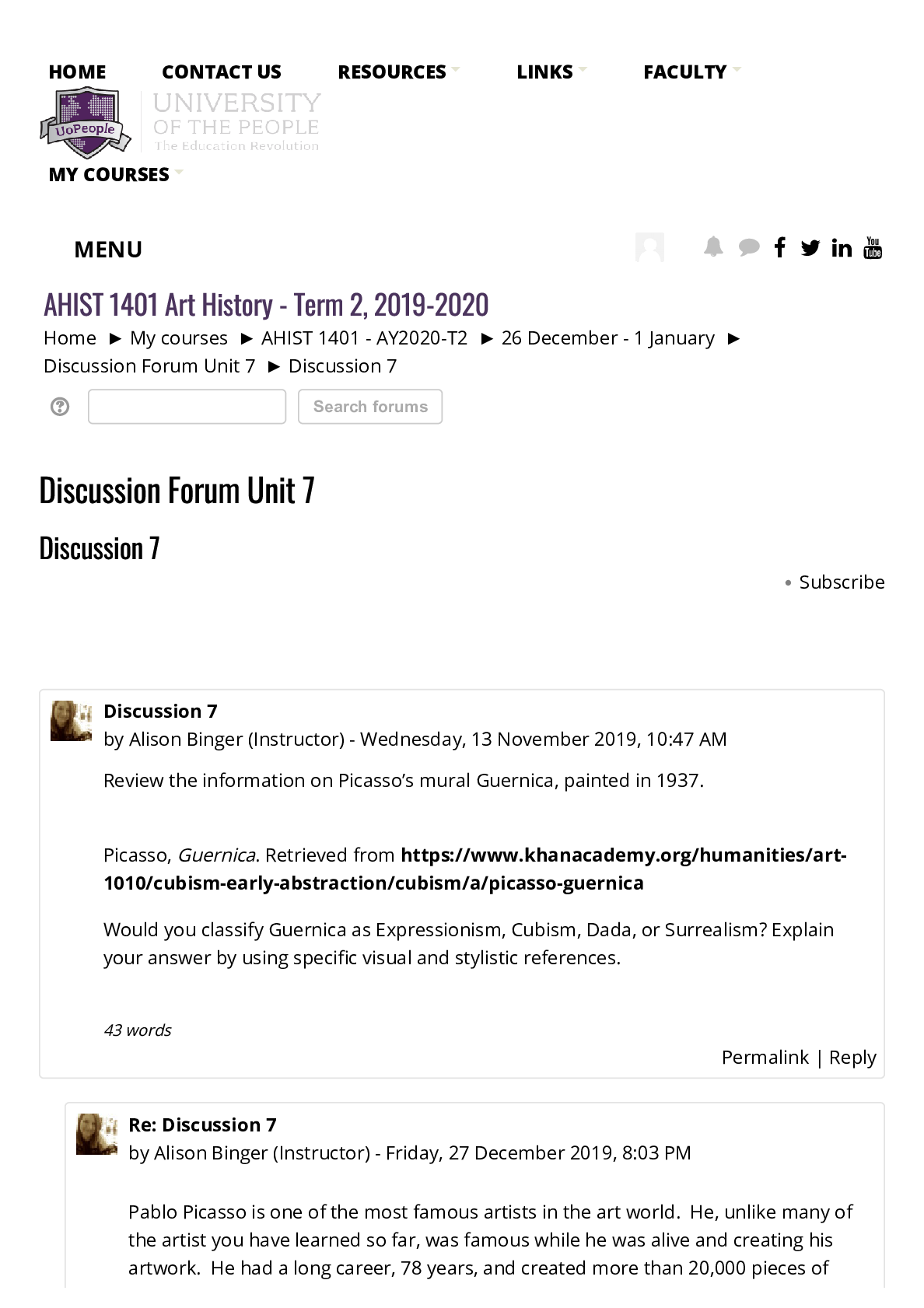
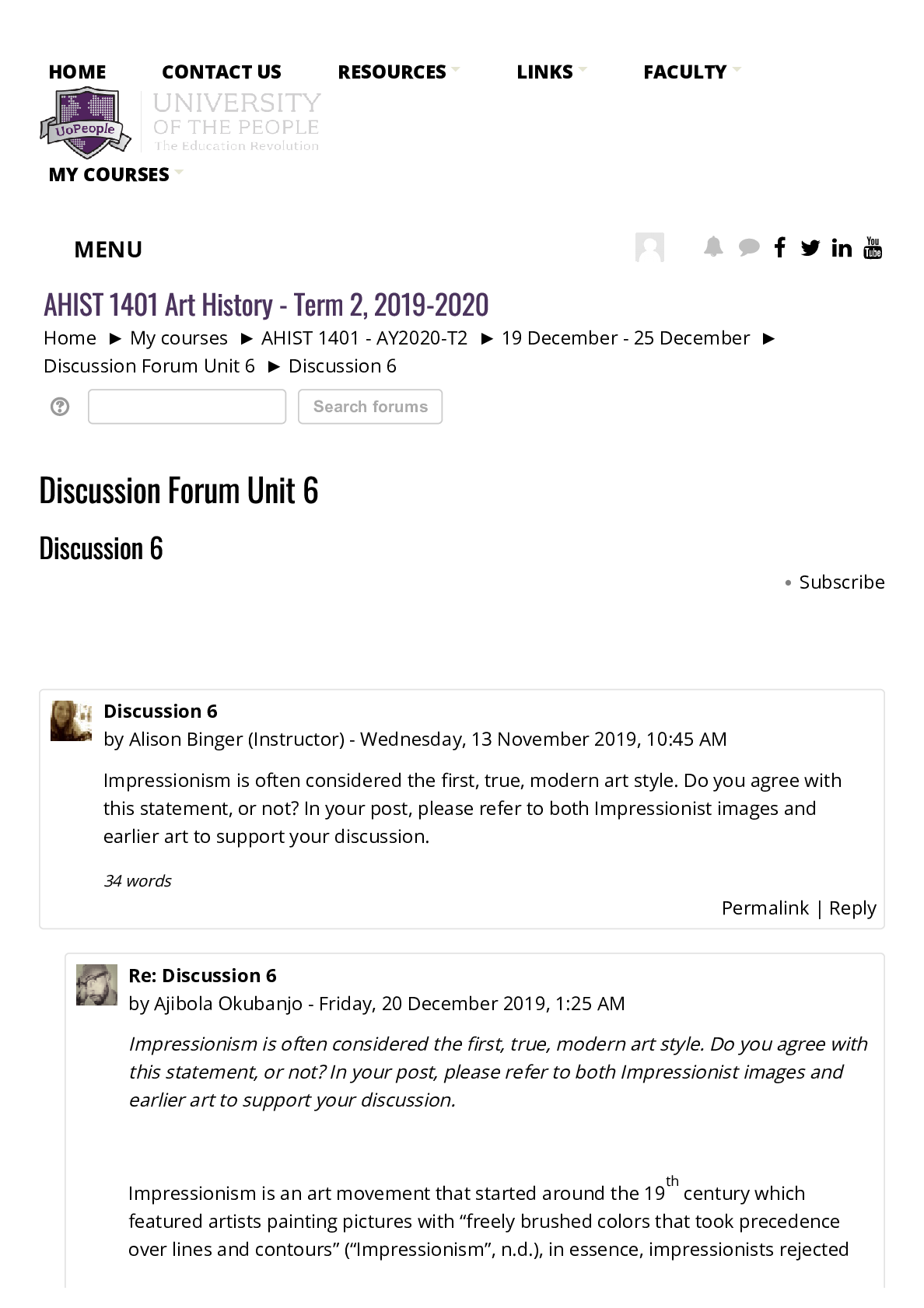
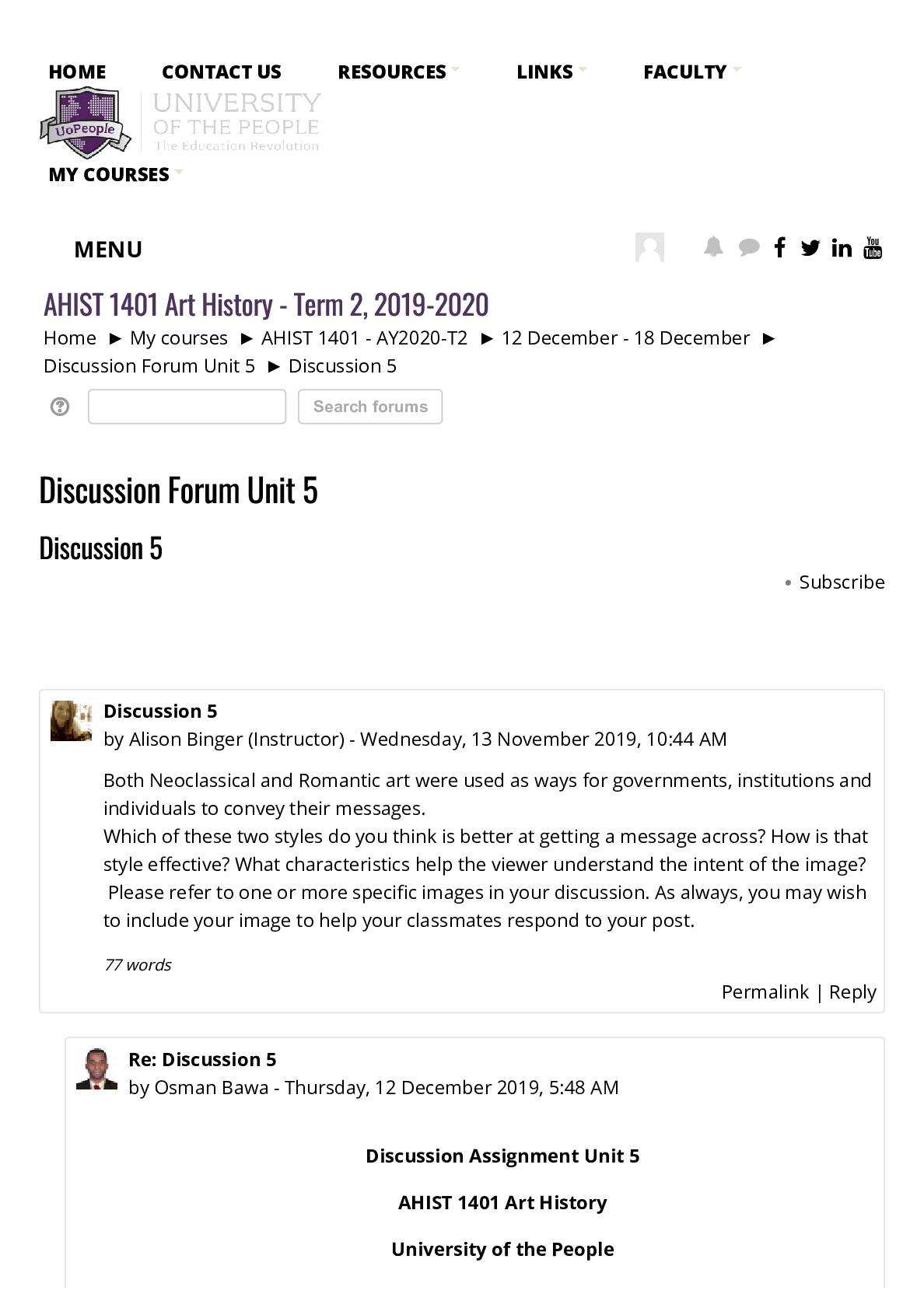
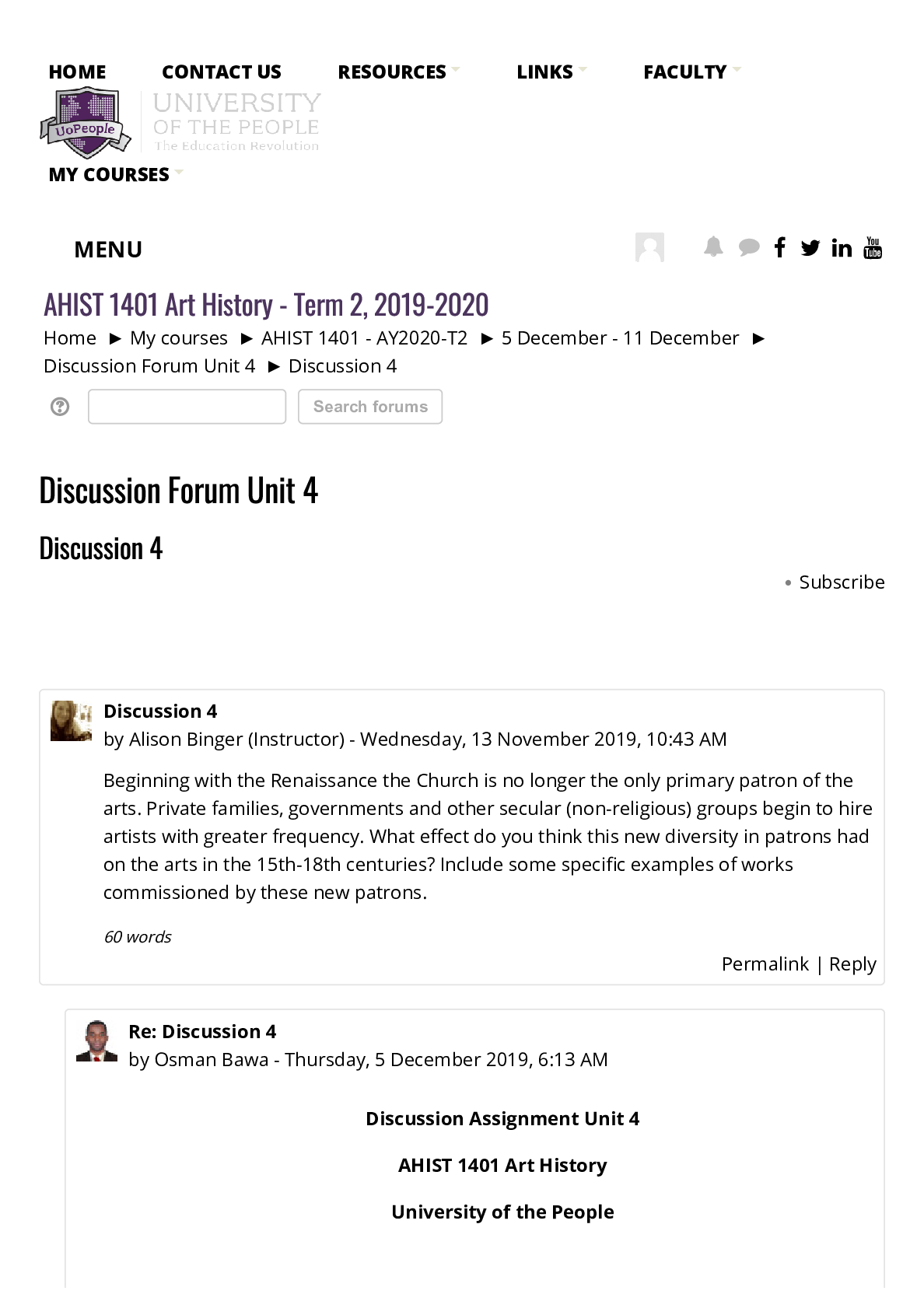

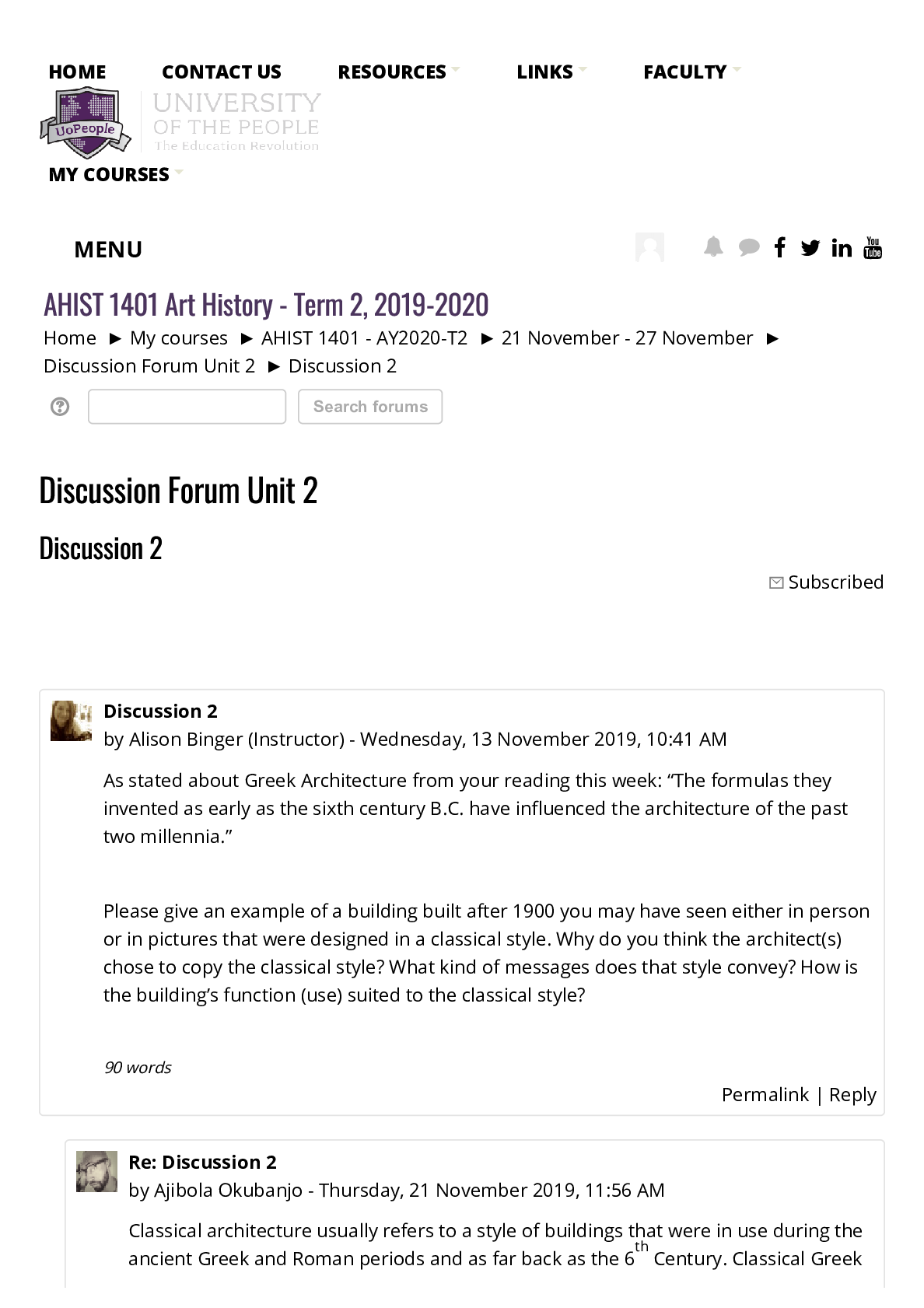
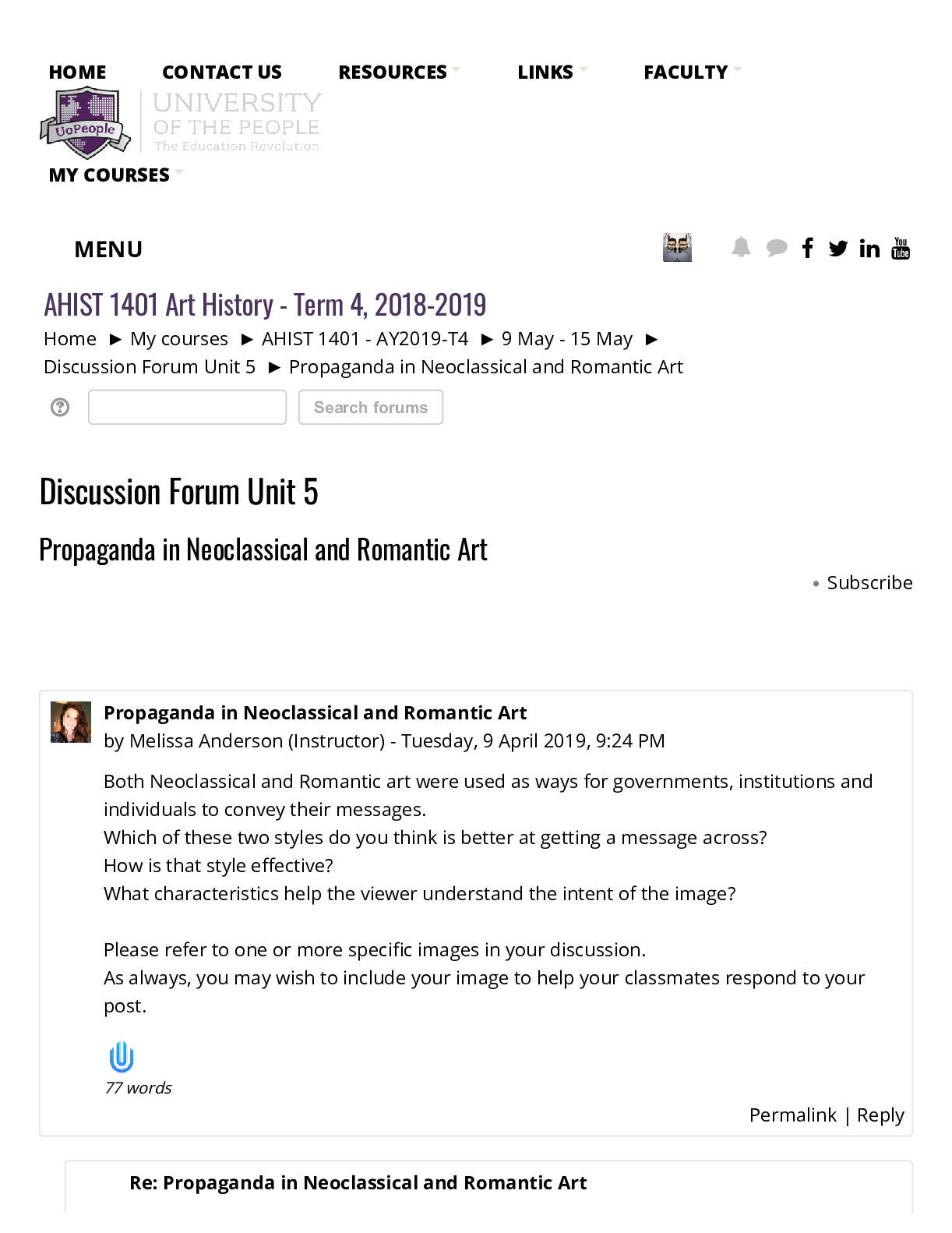
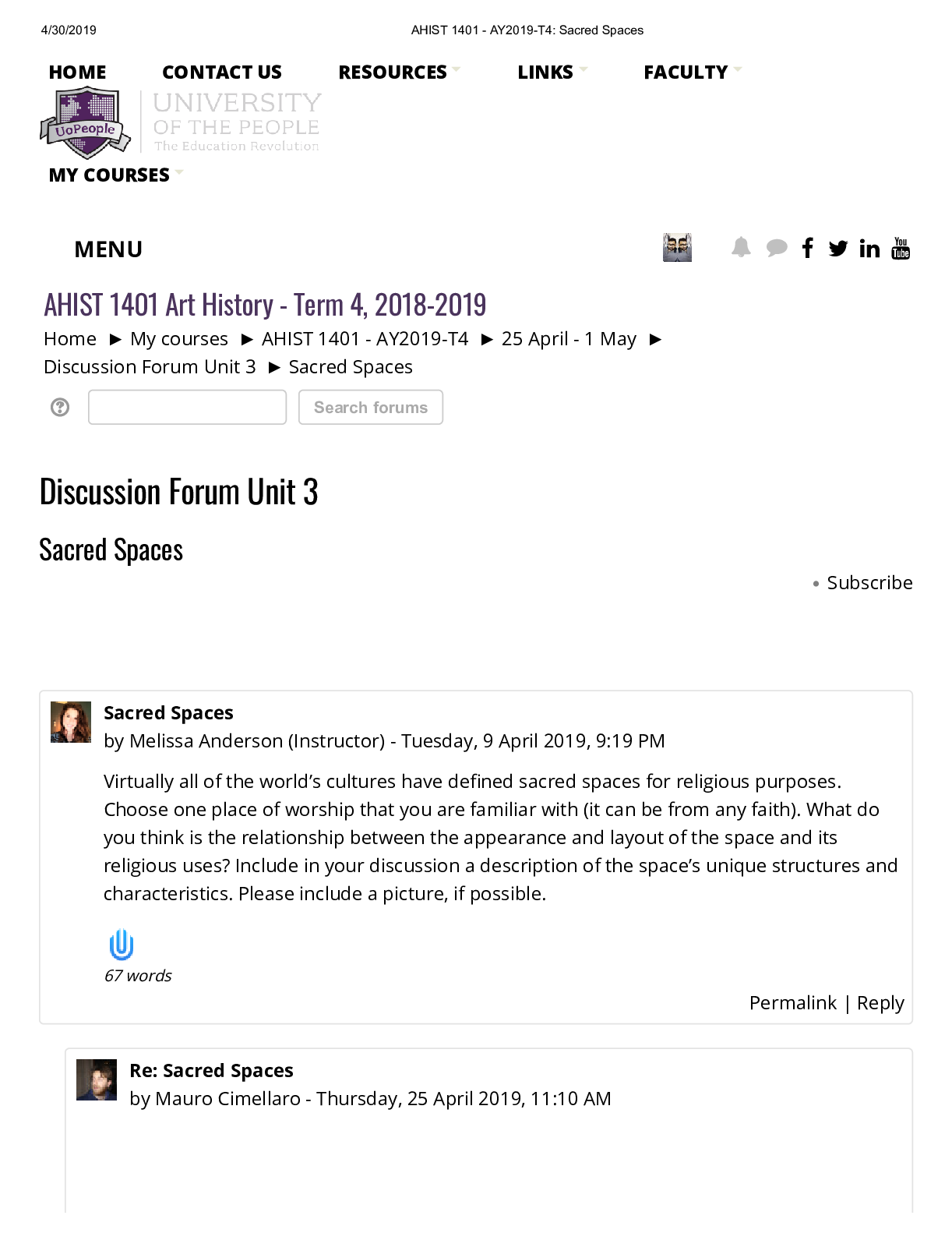
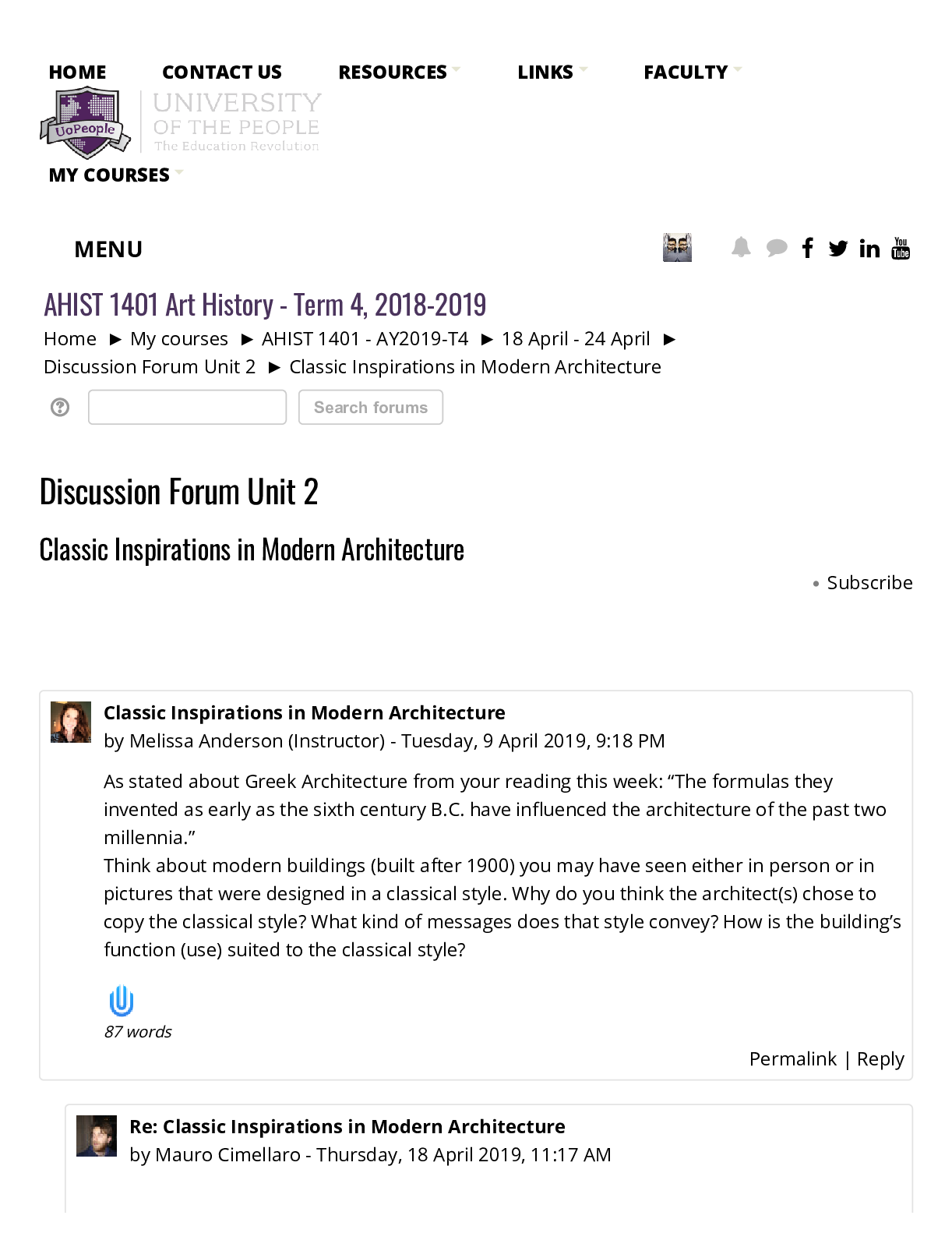


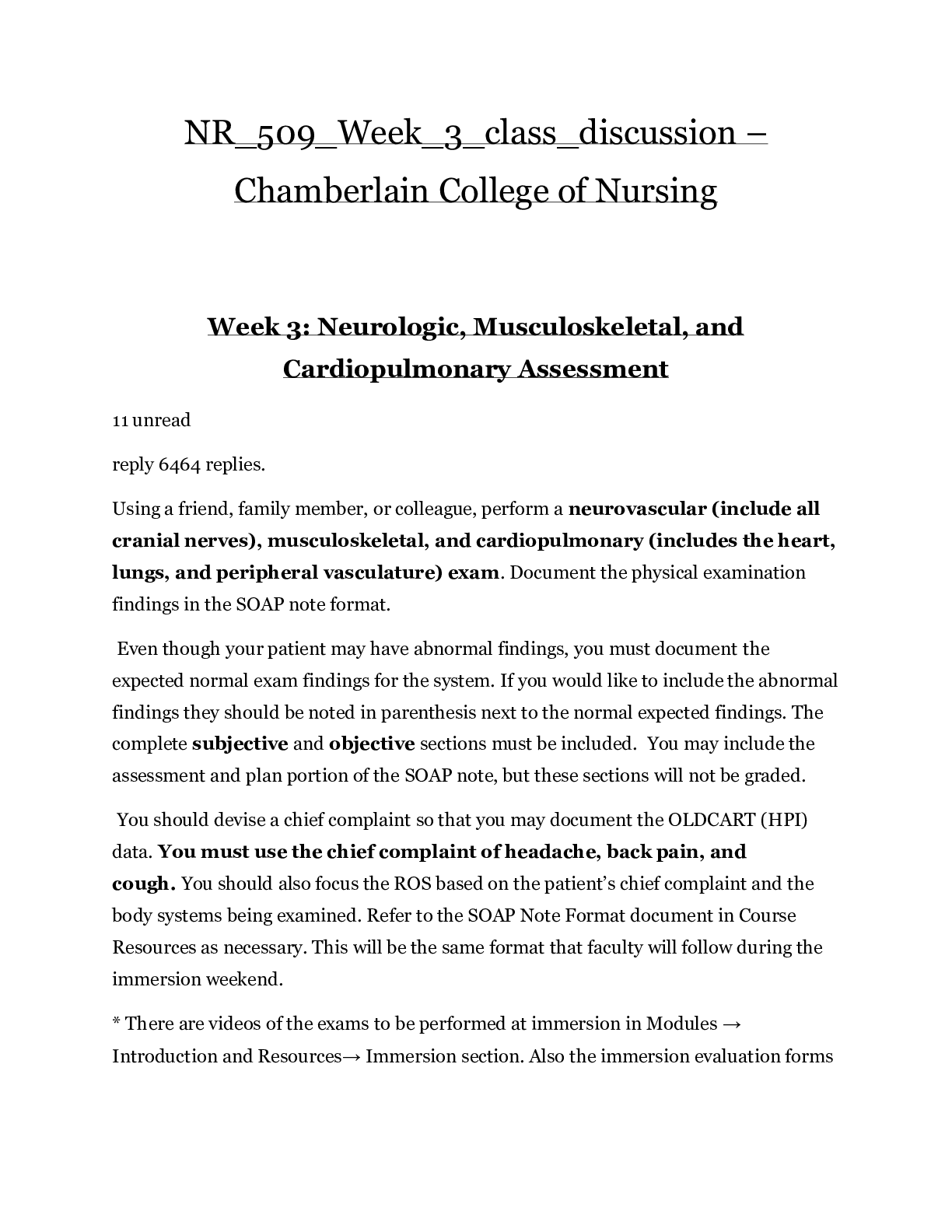
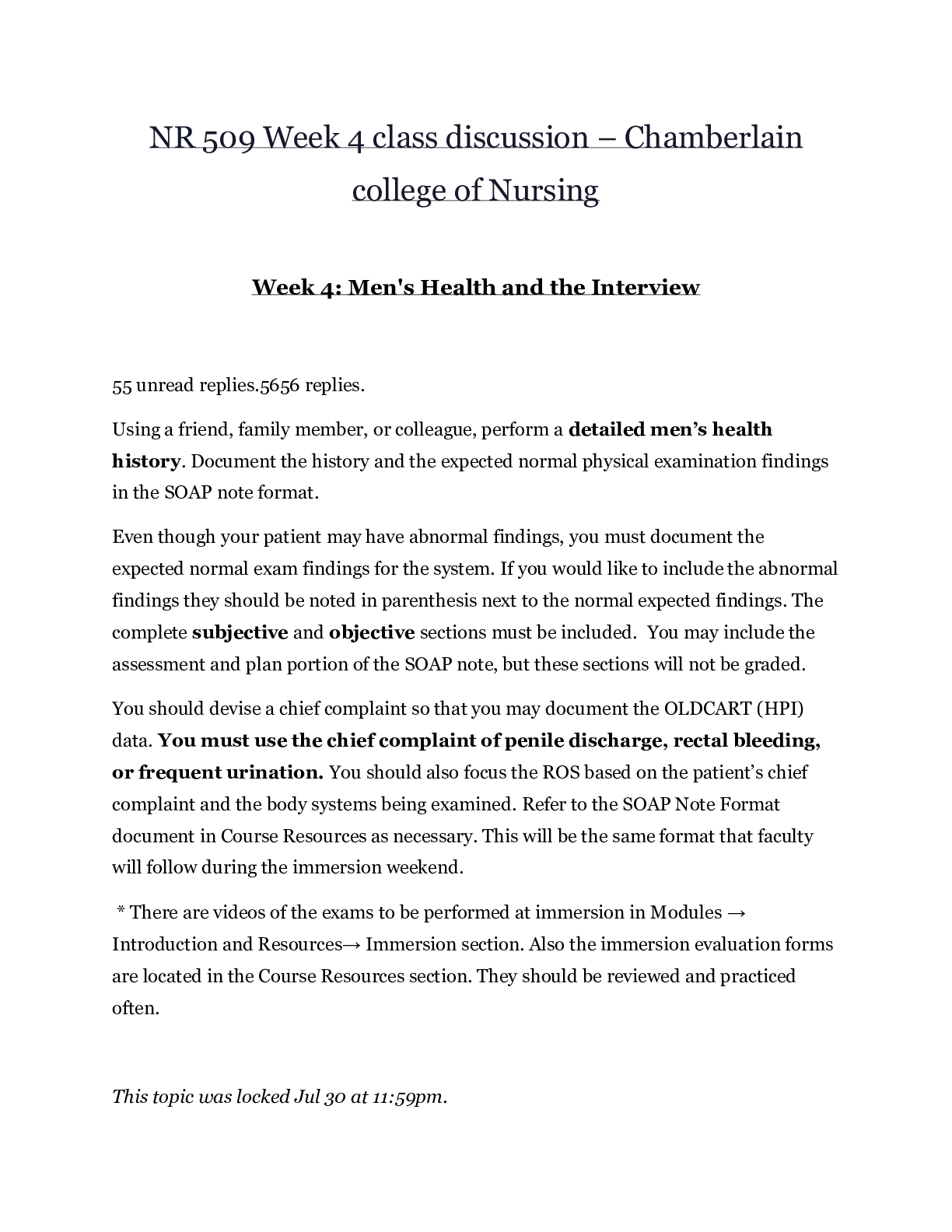

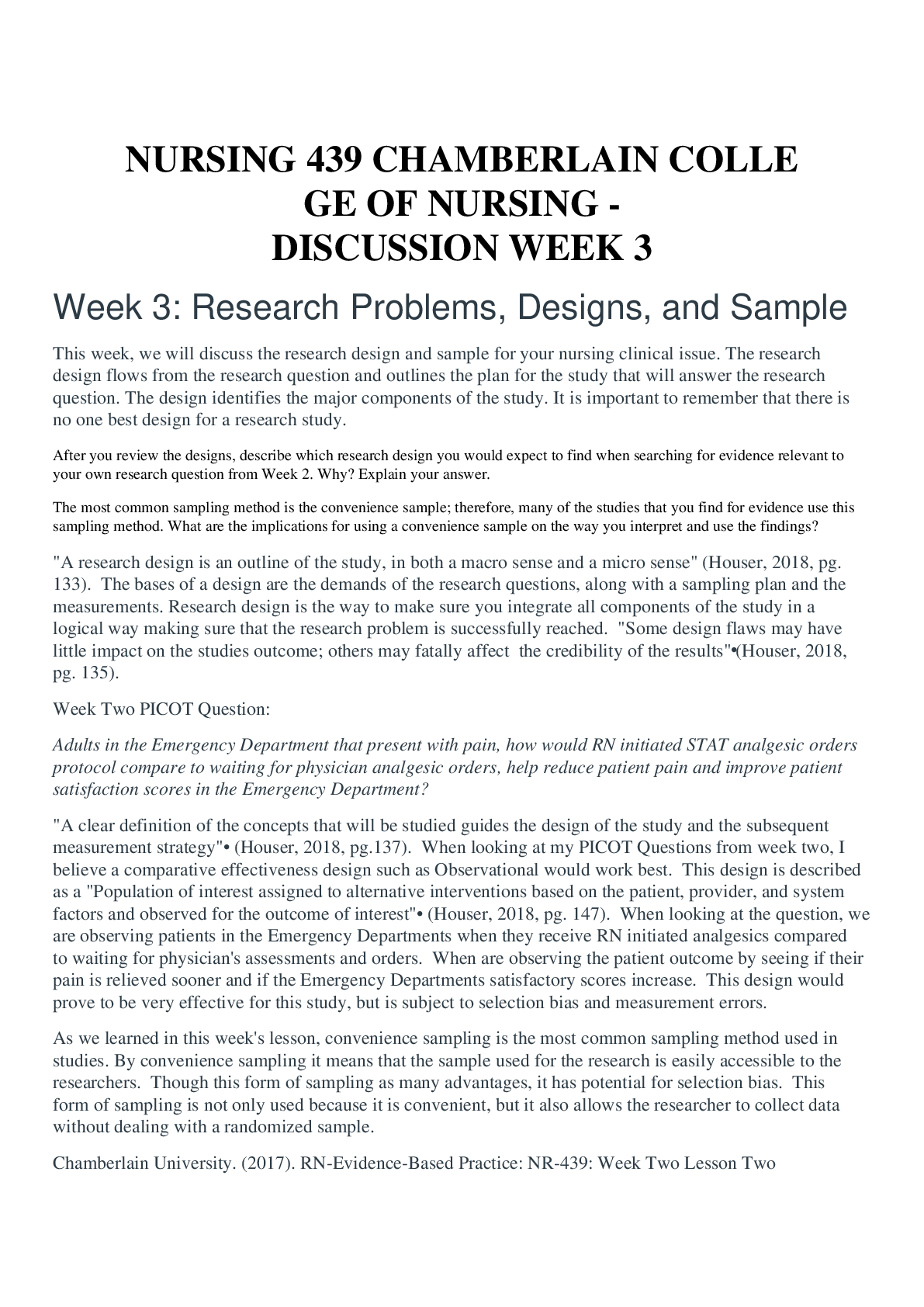
 – Chamberlain College of Nursing.png)


